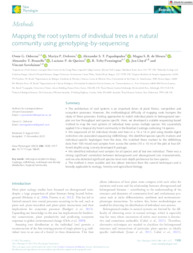Mapping the root systems of individual trees in a natural community using genotyping-by-sequencing.
Mapping the root systems of individual trees in a natural community using genotyping-by-sequencing.
Author(s): OSBORNE, O. G.; DOBREVA, M. P.; PAPADOPULOS, A. S. T.; MOURA, M. S. B. de; BRUNELLO, A. T.; QUEIROZ, L. P. de; PENNINGTON, R. T.; LLOYD, J.; SAVOLAINEN, V.
Summary: The architecture of root systems is an important driver of plant fitness, competition and ecosystem processes. However, the methodological difficulty of mapping roots hampers the study of these processes. Existing approaches to match individual plants to belowground samples are low-throughput and species-specific. Here, we developed a scalable sequencing-based method to map the root systes of individual trees across multiple species. We successfully applied it to a tropical dry forest community in the Brazilian Caatinga containing 14 species We sequenced all 42 individual shrubs and trees in a 14 by 14 m plot using double-digest restriction-site associated sequencing (ddRADseq). We identified species-specific markers and individual-specific haplotypes from the data. We matched these markers to ddRADseq data from 100 mixed root samples from across the centre (10 by 10 m) of the plot at four different depths, using a newly developed R package We identified individual root samples for all species and all but one individual. There was a strong significant correlation between below and aboveground size measurements, and we also detected significant species-level root-depth preference for two species.? The method is more scalable and less labour-intensive than current techniques, and is broadly applicable to ecology, forestry and agricultural biology.
Publication year: 2023
Types of publication: Journal article
Unit: Embrapa Semi-arid Region
Observation
Some of Embrapa's publications are published as ePub files. To read them, use or download one of the following free software options to your computer or mobile device. Android: Google Play Books; IOS: iBooks; Windows and Linux: Calibre.
Access other publications
Access the Agricultural Research Database (BDPA) to consult Embrapa's full library collection and records.
Visit Embrapa Bookstore to purchase books and other publications sold by Embrapa.

